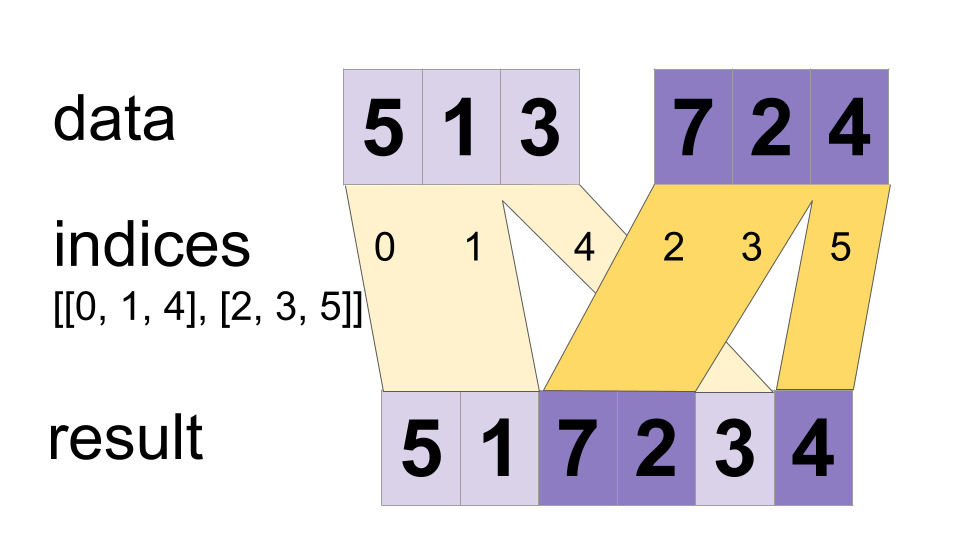將 data 張量中的值交錯成單個張量。
用法
tf.raw_ops.DynamicStitch(
indices, data, name=None
)參數
-
indices至少 1 個Tensor類型為int32的對象的列表。 -
data與具有相同類型的Tensor對象的indices長度相同的列表。 -
name操作的名稱(可選)。
返回
-
一個
Tensor。具有與data相同的類型。
構建一個合並的張量,使得
merged[indices[m][i, ..., j], ...] = data[m][i, ..., j, ...]例如,如果每個 indices[m] 是標量或向量,我們有
# Scalar indices:
merged[indices[m], ...] = data[m][...]
# Vector indices:
merged[indices[m][i], ...] = data[m][i, ...]每個 data[i].shape 必須以相應的 indices[i].shape 開頭,並且 data[i].shape 的其餘部分必須是常量 w.r.t。 i 。也就是說,我們必須有 data[i].shape = indices[i].shape + constant 。就這個 constant 而言,輸出形狀是
merged.shape = [max(indices)] + constant值按順序合並,因此如果索引同時出現在 indices[m][i] 和 indices[n][j] 中,則 (m,i) < (n,j) 切片 data[n][j] 將出現在合並結果中。如果您不需要此保證,ParallelDynamicStitch 可能在某些設備上表現更好。
例如:
indices[0] = 6
indices[1] = [4, 1]
indices[2] = [[5, 2], [0, 3]]
data[0] = [61, 62]
data[1] = [[41, 42], [11, 12]]
data[2] = [[[51, 52], [21, 22]], [[1, 2], [31, 32]]]
merged = [[1, 2], [11, 12], [21, 22], [31, 32], [41, 42],
[51, 52], [61, 62]]此方法可用於合並由dynamic_partition 創建的分區,如下例所示:
# Apply function (increments x_i) on elements for which a certain condition
# apply (x_i != -1 in this example).
x=tf.constant([0.1, -1., 5.2, 4.3, -1., 7.4])
condition_mask=tf.not_equal(x,tf.constant(-1.))
partitioned_data = tf.dynamic_partition(
x, tf.cast(condition_mask, tf.int32) , 2)
partitioned_data[1] = partitioned_data[1] + 1.0
condition_indices = tf.dynamic_partition(
tf.range(tf.shape(x)[0]), tf.cast(condition_mask, tf.int32) , 2)
x = tf.dynamic_stitch(condition_indices, partitioned_data)
# Here x=[1.1, -1., 6.2, 5.3, -1, 8.4], the -1. values remain
# unchanged.
相關用法
- Python tf.raw_ops.DynamicPartition用法及代碼示例
- Python tf.raw_ops.DecodeGif用法及代碼示例
- Python tf.raw_ops.DepthToSpace用法及代碼示例
- Python tf.raw_ops.DepthwiseConv2dNative用法及代碼示例
- Python tf.raw_ops.DeserializeManySparse用法及代碼示例
- Python tf.raw_ops.Dilation2D用法及代碼示例
- Python tf.raw_ops.Dequantize用法及代碼示例
- Python tf.raw_ops.DeserializeSparse用法及代碼示例
- Python tf.raw_ops.DataFormatVecPermute用法及代碼示例
- Python tf.raw_ops.DiagPart用法及代碼示例
- Python tf.raw_ops.DecodeProtoV2用法及代碼示例
- Python tf.raw_ops.Diag用法及代碼示例
- Python tf.raw_ops.TPUReplicatedInput用法及代碼示例
- Python tf.raw_ops.Bitcast用法及代碼示例
- Python tf.raw_ops.SelfAdjointEigV2用法及代碼示例
- Python tf.raw_ops.BatchMatMul用法及代碼示例
- Python tf.raw_ops.OneHot用法及代碼示例
- Python tf.raw_ops.ResourceScatterNdSub用法及代碼示例
- Python tf.raw_ops.ReadVariableXlaSplitND用法及代碼示例
- Python tf.raw_ops.GatherV2用法及代碼示例
注:本文由純淨天空篩選整理自tensorflow.org大神的英文原創作品 tf.raw_ops.DynamicStitch。非經特殊聲明,原始代碼版權歸原作者所有,本譯文未經允許或授權,請勿轉載或複製。
